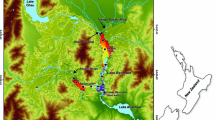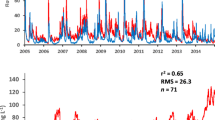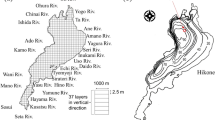Abstract
Nutrient pollution causes frequent blooms of potentially harmful cyanobacteria in Lake Peipsi (Estonia/Russia). Although external nutrient loading has reduced since the 1990s, lake water quality has barely improved, and eutrophication is still considered a threat to lake biota and water usage. To understand the recovery dynamics of the lake it is necessary to analyse the effects of land use and lake management on water quality to develop mitigation strategies. Comprehensive analysis has thus far failed due to information gaps inherent to conventional monitoring strategies. We show how two large-scale hydrological models using Earth observation data provide spatial information on pollution and can help explain the causes of past and current lake eutrophication. WaterGAP3.2 provides valid estimates of present and probable future phosphorus concentration in the lake water, based on past hydrological conditions. WaterWorld models spatial potential water quality and a scenario of optimal pollution reduction. Remotely sensed optical water quality data can be used to analyse recent, spatial water quality dynamics. The spatial and temporal algae distributions and can help explain eutrophication causes at Lake Peipsi and its catchment, adding value to in situ monitoring and supporting river basin management with large scale data.


Similar content being viewed by others
References
Alcamo J et al (2003) Development and testing of the WaterGAP 2 global model of water use and availability. Hydrologi Sci-J-des Sci Hydrol:317–337
Astover A, Rossner H (2013) Phosphorus status of agricultural soils in Estonia. Knowledge report, Baltic Forum for Innovative Technologies for Sustainable Manure Management
aus der Beek T, Flörke M, Lapola DM, Teichert E (2010) Modelling historical and current irrigation water demand on the continental scale: Europe. Adv Geosci:79–85
Bicheron P et al (2011) Geolocation assessment of MERIS GlobCover Orthorectified products. IEEE Trans Geosci Remote Sensing:2972–2982
Blank K, Loigu E, Laugaste R, Haberman J (2017) The ecological state of Lake Peipsi (Estonia/Russia): improvement, stabilization or deterioratioin? Proc Eston Acad Sci Ecol 18:–28
Bouvet M, Ramoino F (2010) Equalization of MERIS L1b products from the 2nd reprocessing. ESA TN TEC-EEP/2009.521/MB
Buhvestova O, Kangur K, Haldna M, Möls T (2011) Nitrogen and phosphorus in Estonian rivers discharging into Lake Peipsi: estimation of loads and seasonal and spatial distribution of concentrations. Eston J Ecol:18–38
Eisner S (2016) Comprehensive evaluation of the WaterGAP3 model across climatic, physiographic, and anthropogenic gradients. Universitätsbibliothek Kassel, Kassel
EU (2000) Directive 2000/60/EC of the European Parliament and the council. Off J Eur Comm
Fink G, Alcamo J, Flörke M, Reder K (2018) Phosphorus loadings to the world's largest lakes: sources and trends. Glob Biogeochem Cycl:617–634
Flörke M, Kynast E, Bärlund I, Eisner S, Wimmer F, Alcamo J (2013) Domestic and industrial water uses of the past 60 years as a mirror of socio-economic development: a global simulation study. Glob Environ Chang:144–156
Gilerson AA et al (2010) Algorithms for remote estimation of chlorophyll-a in coastal and inland waters using red and near infrared bands. Opt Express:24109–24125
Gons HJ, Rijkeboer M, Ruddick KG (2005) Effect of a waveband shift on chlorophyll retrieval from MERIS imagery of inland and coastal waters. J Plankton Res:125–127
Heinsalu A, Alliksaar T, Leeben A, Noges T (2007) Sediment diatom assemblages and composition of pore-water dissolved organic matter reflect recent eutrophication history of Lake Peipsi (Estoni/Russia). Hydrobiologia:133–143
Imboden DM (1974) Phosphorus model of lake eutrophication. Limnol Oceanogr:297–304
Ital A, Stalnacke P, Deelstra J, Loigu E, Pihlak M (2005) Effects of large-scale changes in emissions on nutrient concentrations in Estonian rivers in the Lake Peipsi drainage basins. J Hydrol:261–273
Jaani A (1996) Hydrology and water balance of Lake Peipsi. Hydrobiologia:11–23
Jeppesen E et al (2005) Lake responses to reduced nutrient loading - an analysis of contemporary long-term data from 35 case studies. Freshw Biol:1747–1771
Jeppesen E, Kronvang B, Meerhoff M, Sondergaard M, Hansen KM, Andersen HE (2009) Climate change effects on runoff, catchment phosphorus loading and lake ecological state, and potential adaptations. J Envrion Qual:1930–1941
Kangur K, Kangur A, Kangur P, Laugaste R (2005) Fish kill in Lake Peipsi in summer 2002 as a synergistic effect of a cyanobacterial bloom, high temperature, and low water level. Proc Estonian Acad Sci Ecol:67–80
Kangur K, Kangur A, Raukas A (2012) Peipsi Lake in Estonia/Russia. In Encyclopedia of Lakes and Reservoirs, von L. Bengtsson, R. W. Herschy, & R. W. Fairbridge 596–607. Springer
Kangur K et al (2013) Long-term effects of extreme weather events and eutrophication on the fish community of Lake Peipsi (Estonia/Russia). J Limnol:376–387
Laugaste R, Nõges P, Nõges T, Yastremskij V, Milius A, Ott I, Algae (2001) In Lake Peipsi. Flora and Fauna, von E. Pihu, & J. Haberman, 31–49. Tartu: Sulemees Publishers
Mäemets H, Palmik K, Haldna M, Sudnitsyna D, Melnik M (2010) Eutrophication and macrophyte species richness in the large shallow north-European Lake Peipsi. Aquat Bot:273–280
Mishra S, Mishra DR, Lee Z (2014) Bio-optical inversion in highly turbid and cyanobacteria-dominated waters. IEEE Trans Geosci Remote Sensing:375–388
Moore TS, Campbell JW, Feng H (2001) A fuzzy logic classification scheme for selecting and blending satellite ocean color algorithms. IEEE Trans Geosci Remote Sens:1764–17776
Mourad DSJ, Van der Perk M, Gooch GD, Loigu E, Piirimäe K, Stalnacke P (2005) GIS-based quantification of future nutrient loads into Lake Peipsi/Chudskoe using qualitative regional development scenarios. Water Sci Technol:355–363
Mulligan M (2009) The human water quality footprint: agricultural, industrial, and urban impacts on the quality of available water globally and in the Andean region. Proceedings of the International Conference on Integrated Water Resource Management and Climate Change. Cali
Mulligan M (2013) WaterWorld: a self-parameterising, physically based model for application in data-poor but problem-rich environments globally. Hydrol Res:748–769
Mulligan M, Burke S (2005) FIESTA fog interception for the enhancement of streamflwo in tropical areas.“ Final Technical report for AMBIOTEK contribution to DFID FRP R7991
Mulligan M, Clifford NA (2015) Is managing ecosystem services necessary and sufficient to ensure sustainable development. Handbook of Sustainable Development. Routledge, Abingdon 179–195
Neitsch SL, Arnold JG, Kiniry JR, Williams JR (2011) Soil and water assessment tool theoretical documentation Version 2009. Texas Water Resources Institute Technical Report No. 406
Paerl HW, Hall NS, Calandrino ES (2011) Controlling harmful cyanobacterial blooms in a world experiencing anthropogenic and climatic-induced change. Sci Total Environ:1739–1745
Park YJ, Ruddick K (2005) Model of remote-sensing reflectance including bidirectional effects for case 1 and case 2 waters. Appl Opt:1236–1249
Piirimäe K, Loigu E, Pachel K, Iital A (2015) Virtual mapping of reference conditions of pollutant load in waterbodies: phosphorus in the Lake Peipsi basin. Boreal Env Res:391–402
Punzet M, Voß M, Voß A, Teichert E, Bärlund I (2012) A global approach to assess the potential impact of climate change on stream water temperatures and related in-stream first order decay rates. J Hydrometeorol:1052–1065
Reder K, Flörke M, Alcamo J (2015) Modeling historical fecal coliform loadings to large European rivers and resulting in-stream concentrations. Environ Model Softw:251–263
Sand-Jensen K, Bruun HH, Baastrup-Spohr L (2017) Decade-long time delays in nutrient and plant species dynamics during eutrophication and reoligotrophication of Lake Fure 1900-2015. J Ecol:690–700
Scheffer M, Hosper S, Meijer M, Moss B, Jeppesen E (1993) Alternative equillibria in shallow lakes. Trends Ecol Evol:275–279
Seitzinger SP, Harrison JA (2005) Sources and delivery of carbon, nitrogen, and phosphorus to the coastal zone: An overview of Global Nutrient Export from Watersheds (NEWS) models and their application. Global Biogeochemical Cycles GB4S01 Ausg
Sivapalan M, Blöschl G, Zhang L, Vertessy R (2003) Downward approach to hydrological prediction. Hydrol Process:2101–2111
Spyrakos E et al. (2017) Optical types of inland and coastal waters. Limnology and Oceanography
Steinmetz F, Deschamps P-Y, Ramon D (2011) Atmospheric correction in presence of sun glint: application to MERIS. Opt Express:9783–9800
Tammeorg O, Horppila J, Laugaste R, Haldna M, Niemistö J (2015) Importance of diffusion and resuspension for phosphorus cycling during the growing season in large, shallow Lake Peipsi. Hydrobiologia:133–144
Verzano K (2009) Climate change impact on flood related hydrological processes: further development and application of a global scale hydrological model. Rep Earth Syst Sci
Voß A et al (2012) Continental scale modelling of in-stream river water quality: a report on methodology, test runs, and scenario application. Hydrol Process:2370–2384
Williams R et al (2012) Assessment of current water pollution loads in Europe: estimation of gridded loads for use in global water quality models. Hydrol Process:2395–2410
Acknowledgements
This work has received funding from the European Union’s Seventh Programme for research, technological development and demonstration under grant agreement No 603608. Calimnos was developed as part of the GloboLakes project funded by the National Environment Research Council of the United Kingdom.
Author information
Authors and Affiliations
Corresponding author
Ethics declarations
Conflict of Interest
None.
Additional information
Publisher’s Note
Springer Nature remains neutral with regard to jurisdictional claims in published maps and institutional affiliations.
Rights and permissions
About this article
Cite this article
Fink, G., Burke, S., Simis, S.G.H. et al. Management Options to Improve Water Quality in Lake Peipsi: Insights from Large Scale Models and Remote Sensing. Water Resour Manage 34, 2241–2254 (2020). https://doi.org/10.1007/s11269-018-2156-5
Received:
Accepted:
Published:
Issue Date:
DOI: https://doi.org/10.1007/s11269-018-2156-5




